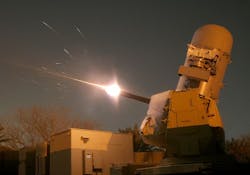Northrop Grumman moving Counter-Rocket, Artillery, and Mortar (C-RAM) capabilities to brigade combat teams
Officials of the Army Contracting Command at Redstone Arsenal, Ala., announced a $71.7 million contract Tuesday to the Northrop Grumman Mission Systems segment in Linthicum, Md., for hardware and services in support of fielding C-RAM warn capability to brigade combat teams.
C-RAM integrates existing field artillery and air defense sensors, a commercial off-the-shelf (COTS) warning system, and a U.S. Navy-developed interceptor to protect forward-deployed warfighters from indirect fire threat. First fielded at key military installations in 2006, C-RAM is helping protect U.S. and coalition troops against mortar and rocket attacks.
C-RAM uses sensor, command and control, and visualization tools to detect incoming threats and locate their sources. Once C-RAM confirms the threat, its command and control (C2) system warns exposed soldiers, and provides track data to the intercept system to destroy the incoming RAM threat, and passes point of origin and point of impact information on to other systems and sensors.
Army officers have warned that the Army's transformation into a modular force has created capability gaps that can leave warfighters unprepared to operate effectively in forward operating areas that are subject to guerilla and terrorist attacks.
Related: Northrop Grumman receives counter-rocket, artillery and mortar contract from U.S. Army
The inactivation of the Army's short-range air defense artillery battalions created capability gaps at the tactical level that prevent the modular brigade combat team from being truly expeditionary by denying them the ability to manage friendly airspace, and to provide early warning and air defense against traditional and asymmetric threats, experts say.
Integrating C-RAM capabilities into brigade combat teams may help close some of those gaps. C-RAM provides capabilities that include audio and visual warnings of incoming mortar attacks, Northrop Grumman officials say.
The brigade combat team is the Army's basic deployable unit of maneuver, and carries equipment and manpower necessary to sustain its operations away from its parent division, including artillery support. Divisions can deploy one or more brigade combat teams to operate independently anywhere in the world.
The Army Contracting Command awarded Tuesday's contract on behalf of the Army's counter-rocket, artillery, and mortar program office. On this contract Northrop Grumman will do the work a various locations, and should be finished by February 2019.
For more information contact Northrop Grumman Mission Systems online at www.northropgrumman.com, or the Army Contracting Command-Huntsville at www.acc.army.mil/contractingcenters/acc-rsa.
